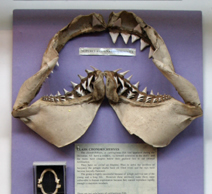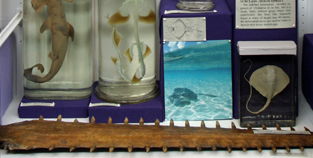
CLASS CHONDRICHTHYES: MODERN CARTILAGINOUS FISH
 |
|||||||||
 |
 |
 |
|||||||
 |
 |
||||||||
 |
|||||||||
 |
|||||||||
 |
|||||||||
The cartilaginous fish first appeared during the Devonian period – among their distinctive features are a cartilaginous skeleton and a forward extension of the skull – the rostrum. Their teeth are not fused to the jaws and are replaced in rows; their scales are denticles formed of enamel and dentine with a pulp cavity. They have a spiral valve in the intestine: a longitudinal fold spiralling down the length of the intestine increasing the digestive area. Claspers on the pelvic fins of the male aid internal fertilisation of the female’s eggs.
Cartilaginous fish have no swim bladders but their cartilaginous skeletons reduce their density and help keep them buoyant. The hydrodynamic lift created by the typical heterocercal tail while the fish swim helps keep them off the bottom. Pelagic sharks also remain buoyant because their livers are filled with oil and oil is lighter than water. Rays and skates are dorso-ventrally flattened and live on the sea-bottom. Chimaeras are also bottom-dwelling fish.
Cartilaginous fish have been very successful because the young have a high survival rate and adults have long lives. Unfortunately these attributes, plus the facts that they are slow-growing and slow to mature, mean that they cannot reproduce rapidly enough to maintain their numbers in the face of expanding fisheries.
The modern cartilaginous fish are assigned to two subclasses:
Subclass Elasmobranchi: sharks, skates & rays
Subclass Holocephali: chimaeras.These two groups have evolved independently for 400 million years since the Permean period.
| ELASMOBRANCHI | HOLOCEPHALI | JAWS AND TEETH |






